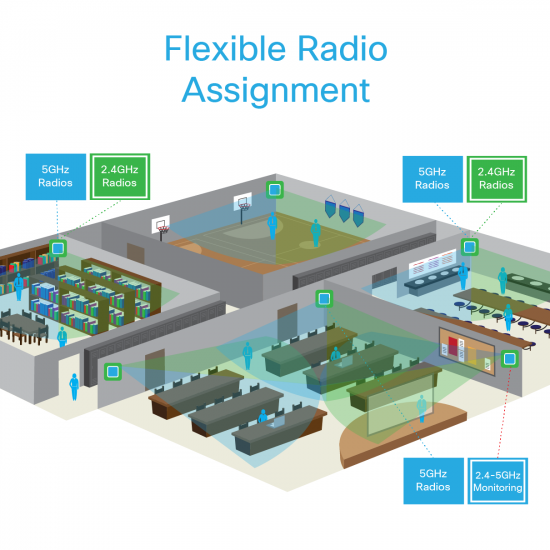If you are in IT, you’re being asked to support more wireless devices – both end user and non-user – as well as the ever growing applications they use. These applications, such as video and collaboration, are far more bandwidth intensive and add large amounts of traffic to the network. This high-density environment could create a bottleneck on your network. Users may carry three or more devices and will come and go at various times, creating an unpredicted high density scenario your network may not be ready for.
With Cisco’s Aironet 2800 and 3800 Series Access Points, we support the latest Wi-Fi Standard 802.11ac Wave 2 providing more bandwidth for more devices. We go beyond the standard to provide advanced innovation that self-optimizes your network in those unpredicted times of high density. This feature is called Flexible Radio Assignment. It automatically detects when a high number of devices are connected to a network by using the dual radios in the access point to serve more clients, while still monitoring the network for security threats and RF Interference that may affect performance. Flexible Radio Assignment is a Cisco Innovation designed to provide a better mobile user experience for high density networks.
 Today is not just another ordinary day at Cisco University. Though students are dispersed throughout the school, the entirety of the student body will gather for a surprise guest speaker in the lecture hall.
Today is not just another ordinary day at Cisco University. Though students are dispersed throughout the school, the entirety of the student body will gather for a surprise guest speaker in the lecture hall.
As students begin to filter into the lecture room, the lecture hall’s Cisco Aironet 2800 and Aironet 3800 Access Points automatically determine there is ample 2.4 GHz and 5 GHz wireless coverage. One of the access points converts one of its radios into monitor mode where it continually scans the 2.4 GHz and 5 GHz bands for radio frequency interference or security threats.
 For those unable to see the guest speaker in person, a student turns on a wireless camera so that people can view the lecture remotely. Unfortunately the video camera creates RF interference that may affect the wireless network’s performance.
For those unable to see the guest speaker in person, a student turns on a wireless camera so that people can view the lecture remotely. Unfortunately the video camera creates RF interference that may affect the wireless network’s performance.
Since one of the Cisco Aironet Access Points is in Monitor mode, CleanAir’s spectrum-aware, self-healing and self-optimizing wireless network technology automatically kicks in. It detects the interference and CleanAir eliminates the interference in the lecture hall.
 Whoa! The lecture hall is fuller than expected and everyone is using their mobile devices to record the guest speaker. Adapting to the high-density environment, the Cisco Aironet 2800 and 3800 Access points use the Flexible Radio Assignment feature to convert all radios to the 5GHz band. This allows the access points to serve the additional clients while providing better coverage and performance during this high-density event.
Whoa! The lecture hall is fuller than expected and everyone is using their mobile devices to record the guest speaker. Adapting to the high-density environment, the Cisco Aironet 2800 and 3800 Access points use the Flexible Radio Assignment feature to convert all radios to the 5GHz band. This allows the access points to serve the additional clients while providing better coverage and performance during this high-density event.

After an amazing speech students and faculty are filing out of the lecture hall. Now that the area is experiencing less dense Wi-Fi traffic so redundant radios in the Cisco Aironet Access Points are automatically converted back to regular operations. The hall’s other access point transitions its 2.4GHz radio to “monitor” mode, detecting security issues or RF interference on the network.


Informative!!!
Interesting but what happens in the case of “the system decided to quit monitor mode to start servicing 5ghz clients” and suddenly the video camera changes its channel automatically to one channel that kills again your wireless performance ? Are you keeping “monitor mode” at least on the channel you are servicing clients ?
@Lionel, thank you for the insightful question.
The answer is: yes with or without a flexible radio in dedicated monitor mode – we will always be monitoring the serving channel on all of the radios. This is true whether its configured for 2.4 or 5 GHz that are serving clients. This is as per todays capability and this is carried forward.
I certainly enjoy hearing from you guys, so please let me know if you have other questions! Thanks again!